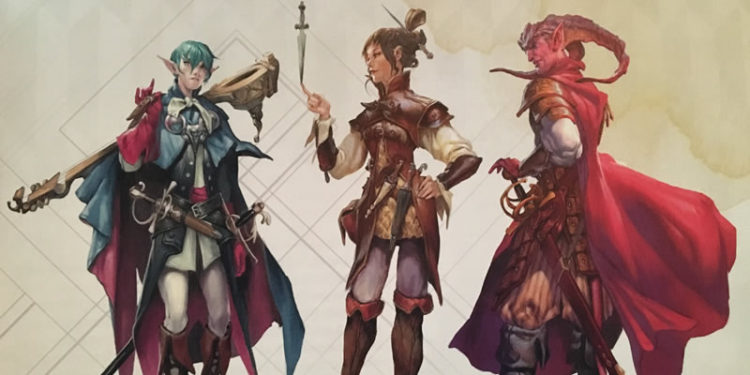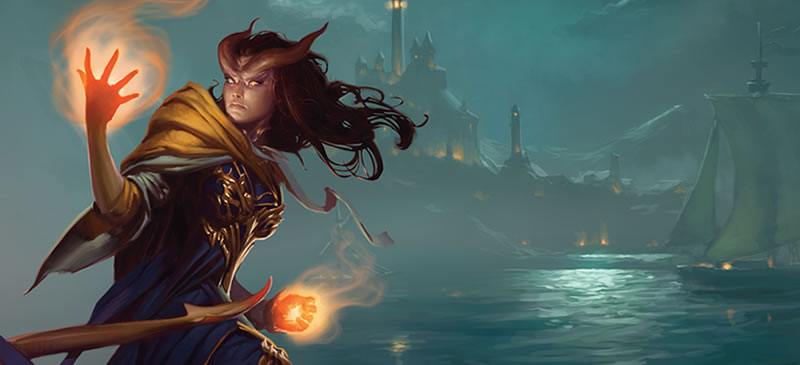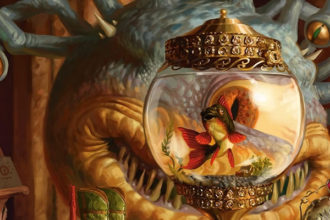Xanathar’s Expanded Backstories

Xanathar’s Guide to Everything has been selectively available since November 10th and is available everywhere on November 21st (previously covered with a preview and review). Over a third of the book focuses on character options, which includes 27 new subclasses that have been drawing the most attention. This section also is full of excellent optional tools to flesh out your any D&D character’s backstory in the form of random tables tied to your class and backstory. The chapter also closes out with racial feats for all of the non-races found in the PHB (oops! I keep forgetting humans get the Prodigy feat).
In this article, I’ll be briefly taking a look at each of these sections as I create a PC with all of the new expanded background content. My example will show just how extensive the new character background tools are.
For a more detailed look at what the book includes visit my Xanathar’s Guide to Everything preview and review.
Base Character Options
Let’s start with what I already can know about my character from the Player’s Handbook, which already contains good options to generate your height, weight and background. Here’s my tiefling bard character build. I’m starting at level 4, so that I can choose a bardic college and gain a racial feat for this example.
Ability Scores: STR: 8 | DEX: 14 | CON: 12 | INT: 14 (13+1) | WIS: 10 | CHA: 17 (15+2)
Race: Tiefling
- Name: – (Let’s use Xanathar’s instead)
- Ability Score: CHA +2, INT +1
- Age: – (Let’s use Xanathar’s instead)
- Sex: Female
- Height (2d8): 4’9″ + 9 = 5’6″
- Weight (2d4): 110 lb. + (9 x 2) = 128 lb
- Alignment: CG (the PHB suggests Tieflings are chaotic and I like playing good characters)
- Size: Medium
- Speed: 30′
- Darkvision, Hellish Resistance, Infernal Legacy
- Language: Common, Infernal
Class: Bard
- Hit Points: 27
- Equipment: rapier, entertainer’s pack, flute, leather armor, dagger
- Skills: Deception, Intimidation, Persuasion
- Features: Spellcasting, Bardic Inspiration, Jack of All Trades, Song of Rest, Expertise
Subclass: College of Swords
- Bonus Proficiencies: Medium armor and scimitar
- Fighting Style: Dueling
- Blade Flourish
Background: Entertainer
- Skill & Tool Proficiencies: Acrobatics, Performance, Disguise kit, one type of musical instrument
- Equipment: Lute, love letter, a costume, and a belt pouch containing 15 gp
- Entertainer Routine (d10): 5 = Juggler
- Feature: By Popular Demand
- Personality Trait (d8): 3 = I’m a hopeless romantic, always searching for that “special someone.”
- Ideal (d6): 3 = Creativity. The world is in need of new ideas and bold action. (Chaotic)
- Bond (d6): 6 = I would do anything for the other members of my old troupe.
- Flaw (d6): 2 = I’m a sucker for a pretty face.

image from the D&D 5e Player’s Handbook
Expanded Character Background Options
I took the time to generate all of the new optional backstory elements using the tools in Xanathar’s Guide to Everything.
Class Aspects
For each class, we’re provided with new tools to add expanded details to our PCs background. Since I’ll be creating a bard, I can draw inspiration from the tools to create a defining work, find the ultimate instrument, remember an embarrassment and find a muse for my PC.
- Defining work (d6): 4 = “The Pirates of Luskan”, my PCs firsthand account of being kidnapped by sea reavers as a child
- Instrument (d6): 6 = A tinker’s harp of gnomish design
- Embarrassment (d6): 2 = The matinee performance when a circus’ owlbear got loose and terrorized the crowd.
- Muse (choose from nature, love and conflict): My PC is on a quest to identify the essence of true love, etc.
This is Your Life
I know my character is a bard with the entertainer background, but what else can I generate about her background? There’s over 12 pages of ideas and random tables to expand your character’s origin, personal decisions, and life events.
Origins
- Parents (d100): 66 = You know who your parents were
- Tiefling Parents (d8): 3 = Both parents human, their infernal heritage dormant until you came along
- Birthplace (d100): 8 = Home
- Siblings (d10): 4 = I rolled 2 (1d3) siblings
- Sibling A: 2 (2d6) = My twin
- Occupation (d100): 16 = Artisan of guild member
- Alignment (3d6): 8 = Neutral Evil
- Status (3d6): 5 = Missing or unknown (hook!!!)
- Relationship (3d4): 6 = Friendly
- Race (d100): 79, 15 = Human (I rerolled until I get human or tiefling)
- Other details (you determine): female, I could also set her name, personality and place in the world
- Sibling B: 5 (2d6) = Older
- Occupation (d100): 77 = Merchant
- Alignment (3d6): 16 = Lawful Neutral
- Status (3d6): 10 = Alive and well
- Relationship (3d4): 5 = Friendly
- Race (d100): 8 = Human
- Other details (you determine): male, I could also set her name, personality and place in the world
- Sibling A: 2 (2d6) = My twin
Family and Friends
- Family (d100): 86 = Mother and father
- Family Lifestyle (3d6): 8 = Poor (-10)
- Childhood Home (d100 + Family Lifestyle): 33 – 10 = 23 = no permanent residence, moved around a lot
- Childhood Memories (3d6 + CHA mod): 12 = I had a few close friends and lived an ordinary childhood
Personal Decisions:
- Background – Entertainer (d6): 6 = a traveling entertainer took me in and taught me the trade
- Class Training – Bard (d6): 3 = I joined a loose society of scholars and orators to learn new techniques of performance and magic
Life Events
- Age (d100): 4 = 20 years or younger = I’ll go with 20
- Life Event (roll 1 d100 for 20 or under): 56 = You spent time working in a job (performer in a troupe) related to your background, start the game with 2 (2d6) more gold

image from The Adversary by Erin M. Evans
Racial Feats
There are 15 new racial feats. Each of the non-human races from the Player’s Handbook can select from two to four racial feats (some shared). The feats really enhance what makes a race unique, with halflings becoming luckier, dwarves getting tougher, dragonborn being even more draconic, tieflings more infernal, and so on. My bard is an tiefling, so I have a couple of feats that I could choose to select when my PC levels up. The feats are Flames of Phlegethos and Infernal Combustion.
For my PCs level 4 ability score improvement, I am going to select a racial feat using the optional feat rules. I think I’ll go with Flames of Phlegethos, since it bumps up her Charisma by 1 and lets him “call on hellfire”.
Random Names
In Appendix B, you’ll find 17 pages of random names for PCs, most of which are for humans from civilizations in our world. In my review I wasn’t super impressed by this section, but it will work to provide a random first name for my tiefling.
After all these rolls, we finally have a name for my character.
- Tiefling, Female (d100): 17 = Bune
- Tiefling, Virtue (d100): 93 = Vice
That’s it folks. I now have a fully fleshed out Tiefling Bard ready to play named Bune, but she prefers to be called Vice. Using the supplemental tables I could have even randomly rolled my character’s alignment, race, and class. It wouldn’t take much work to write up a detailed backstory about my Tiefling with everything I generated.
Let me know in the comments below if you are excited about all of the character background options. If you have the book and tried this out yourself, let us know how it went.


